If you’re looking to spot hidden energy wastes, I recommend checking out the 13 top infrared thermal leak detectors, including models like the HF96 thermal camera, Black+Decker leak detector, and refrigerant leak sensors like Elitech ILD-200. These tools help identify drafts, electrical faults, and refrigerant leaks quickly and accurately. Whether you’re a homeowner or a professional, you’ll find options with different features and budgets. If you’re curious about the best choices, keep exploring further.
Key Takeaways
- Infrared thermal leak detectors identify hidden energy wastes by detecting temperature variations on surfaces and insulation.
- Advanced models offer high-resolution imaging, real-time analysis, and visual overlays for precise leak pinpointing.
- Professional-grade refrigerant leak detectors quickly locate refrigerant escapes, reducing HVAC energy losses.
- Portable and smartphone-compatible options enable convenient, on-the-go inspections for home and commercial use.
- Features like adjustable sensitivity, durability, and data storage ensure accurate, reliable detection in demanding environments.
Etekcity Infrared Thermometer 1025D (Not for Human) with Dual Laser, Non-Contact Voltage Tester

If you’re looking for a versatile infrared thermometer that’s perfect for both household and professional use, the Etekcity Infrared Thermometer 1025D stands out. It measures surface temperatures from -58°F to 1022°F with quick, accurate readings in under 500ms, thanks to dual laser targeting. The adjustable emissivity and large LCD make it easy to get precise measurements on various surfaces, from grills to electrical panels. It also includes a non-contact voltage tester, adding safety for electrical work. Weighing just 8.5 ounces, it’s reliable, user-friendly, and ideal for identifying hot spots or energy leaks efficiently.
Best For: DIY enthusiasts, electricians, and culinary professionals seeking quick, accurate surface temperature readings and electrical safety checks.
Pros:
- Fast response time under 500ms for quick measurements
- Adjustable emissivity for versatile surface accuracy
- Includes non-contact voltage tester for added safety
Cons:
- Uses single 9V battery, which may require frequent replacement
- Not suitable for human or animal temperature measurement
- Limited to surface temperature readings, not internal temperatures
HF96 Thermal Camera with Laser Pointer and 96×96 IR Resolution

The HF96 Thermal Camera stands out for its integrated laser pointer and 96×96 IR resolution, making it ideal for professionals who need quick, precise detection of thermal anomalies in cluttered or hard-to-reach spaces. Its live enhancement boosts image clarity, while the 25Hz frame rate ensures smooth real-time viewing. The device supports temperature measurement from -4°F to 1022°F and offers multiple color palettes for better visualization. Built-in rechargeable batteries last up to 11 hours, and with 4GB storage, you can save over 30,000 images. Its durable IP54 rating and drop resistance make it reliable in various environments, simplifying energy leak detection and insulation inspections.
Best For: professionals conducting thermal inspections in cluttered, hard-to-reach, or challenging environments requiring quick, precise anomaly detection and high-resolution imaging.
Pros:
- Integrated laser pointer and live super resolution imaging enhance accuracy and clarity during inspections.
- Long battery life (up to 11 hours) and large storage capacity support extensive field work without frequent recharging or data transfer.
- Durable design with IP54 rating and drop resistance ensures reliable performance in tough environments.
Cons:
- The basic IR resolution of 96×96 may be less detailed compared to higher-resolution thermal cameras.
- The device’s advanced features and software may require a learning curve for new users.
- Limited to temperature range up to 1022°F, which may not cover extremely high-temperature applications.
BLACK+DECKER Thermal Leak Detector (TLD100)
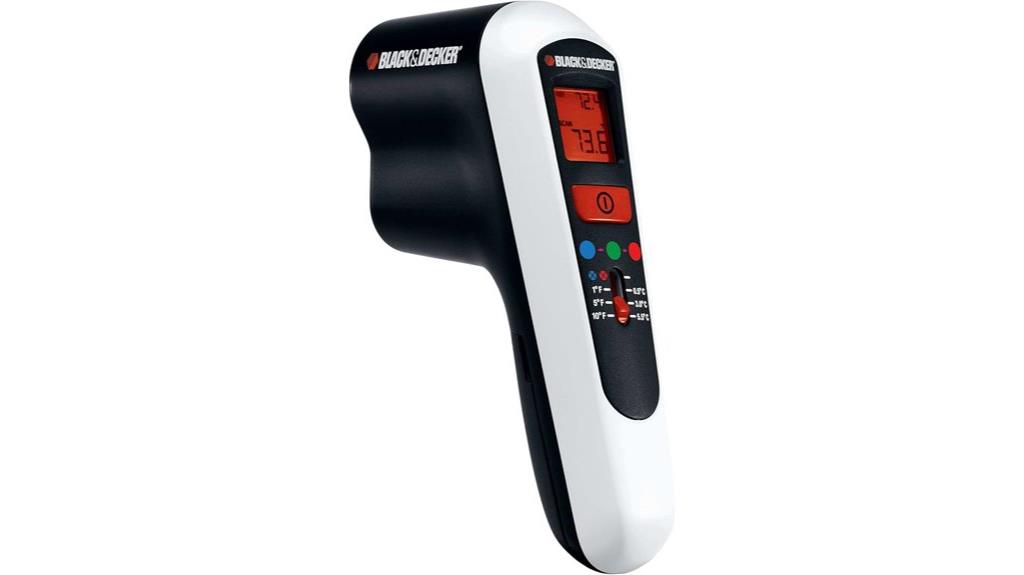
For homeowners seeking an easy-to-use, energy-saving solution, the BLACK+DECKER Thermal Leak Detector (TLD100) offers an excellent choice. It helps cut heating and cooling bills by pinpointing drafts and leaks around your home. With its infrared sensor, it detects surface temperature differences, highlighting warm or cool spots that signal leaks—though it’s not for measuring living beings’ temperatures. The LED indicators quickly show problem areas in red or blue, while the LCD display provides clear temperature readings in Fahrenheit or Celsius. Its ergonomic design makes it comfortable to hold, and the included guide helps you efficiently seal energy leaks, saving up to 20% on energy costs.
Best For: homeowners looking for an easy-to-use, energy-efficient tool to identify and seal home leaks and drafts.
Pros:
- Easy to operate with a user-friendly interface and ergonomic design.
- Accurate temperature detection with infrared sensor and clear LCD display.
- Helps reduce energy bills by up to 20% through effective leak identification.
Cons:
- Not suitable for measuring the temperature of living beings or humans.
- Requires some basic knowledge of sealing leaks for optimal results.
- May not detect leaks that are very subtle or hidden behind walls.
GOYOJO Thermal Imaging Camera with Dual-Light Fusion
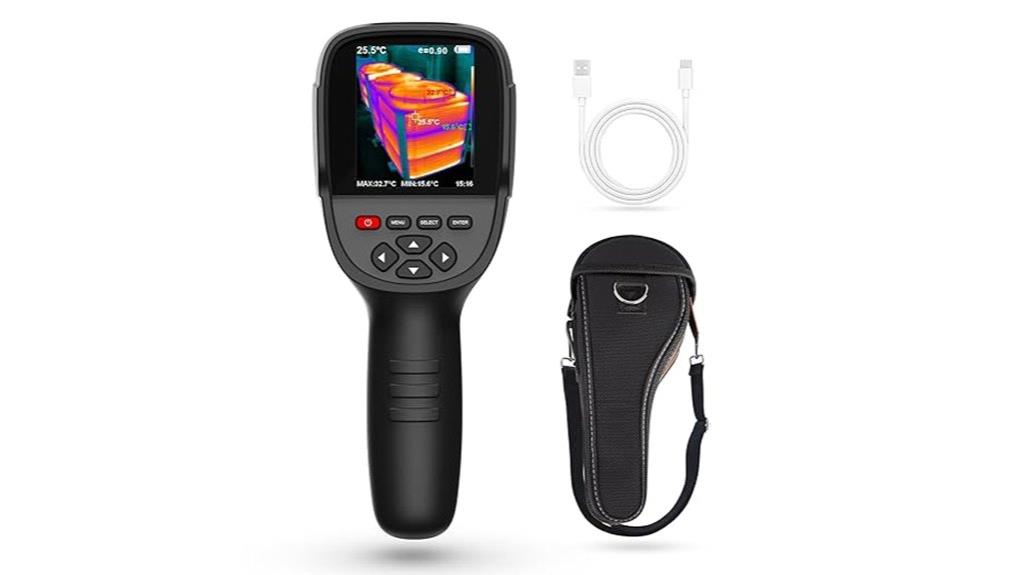
The GOYOJO GW256x192 thermal imaging camera stands out for its dual-light fusion feature, which overlays thermal images onto regular visuals. This makes identifying heat leaks, electrical faults, or insulation issues much easier by providing clear, contextual images. Its high-resolution 256×192 IR sensor captures detailed thermal data, while the adjustable fusion ratio allows me to blend thermal and visible images seamlessly. Designed for professional inspections, it offers real-time temperature tracking, hot and cold spot detection, and durable construction for long-term use. Despite some software concerns, it’s an affordable, user-friendly tool that delivers accurate results for energy audits, building diagnostics, and mechanical troubleshooting.
Best For: professional inspectors and troubleshooters seeking high-resolution thermal imaging with dual-light fusion for building diagnostics, electrical, mechanical, and energy audits.
Pros:
- High-resolution 256×192 IR sensor provides detailed thermal images for precise analysis
- Dual-light fusion overlays thermal images onto regular visuals, enhancing problem identification with clear context
- Durable construction with protective features ensures reliable long-term performance in various environments
Cons:
- Pre-installed software may contain malware; users should replace it with a trusted, malware-free version
- Firmware cannot be updated, limiting future software improvements or bug fixes
- Lacks built-in features like automatic dual-image saving or a built-in flashlight, which could enhance usability
Elitech HVAC Refrigerant Leak Detector
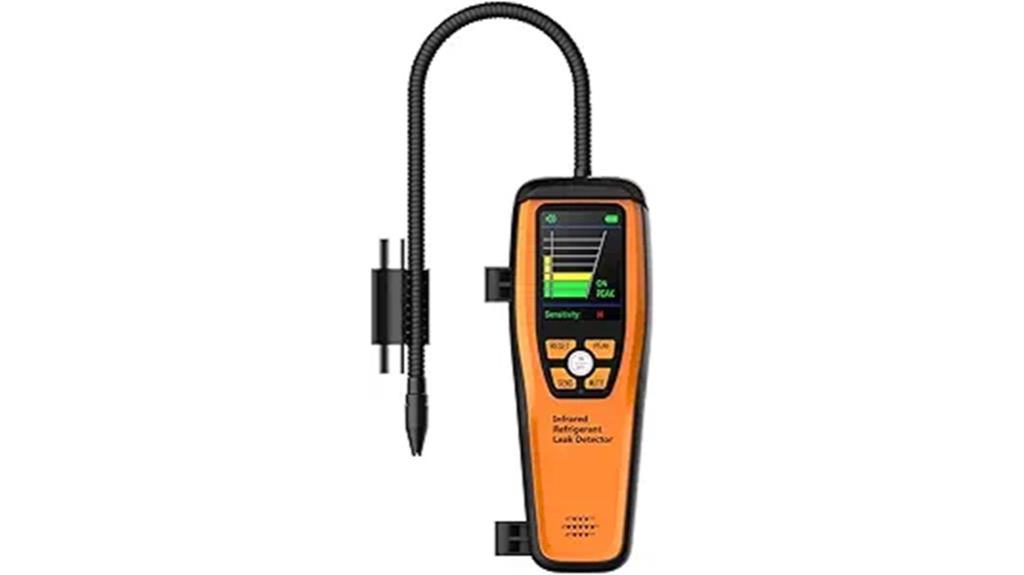
Designed specifically for HVAC professionals, the Elitech ILD-200 refrigerant leak detector offers rapid and accurate detection of all halogenated refrigerants. Its infrared sensor technology guarantees strong anti-interference, fast response times, and high precision, with a service life of up to 10 years. The device detects refrigerants like R410a, R22, and R404a with adjustable sensitivity settings—High, Medium, Low—up to 0.14 oz/yr. Compact and lightweight, it features a clear 2.8-inch display, an audible alarm, and peak detection. Battery-powered and durable, the ILD-200 is reliable for professional HVAC and automotive maintenance, backed by a 1-year warranty and responsive customer support.
Best For: HVAC professionals and automotive technicians seeking rapid, accurate, and reliable refrigerant leak detection with adjustable sensitivity.
Pros:
- Infrared sensor technology provides fast response and high accuracy with strong anti-interference capabilities
- Detects all halogenated refrigerants, including R410a, R22, and R404a, with adjustable sensitivity levels up to 0.14 oz/yr
- Durable, lightweight design with a clear 2.8-inch display and peak detection feature for thorough leak identification
Cons:
- Requires one lithium-ion battery, which may need replacement after extended use
- Limited to professional users; may be complex for casual or DIY applications
- Only offers a 1-year warranty, which is shorter than some competitors’ extended coverage
HP96 Thermal Imaging Camera with 240×240 Resolution
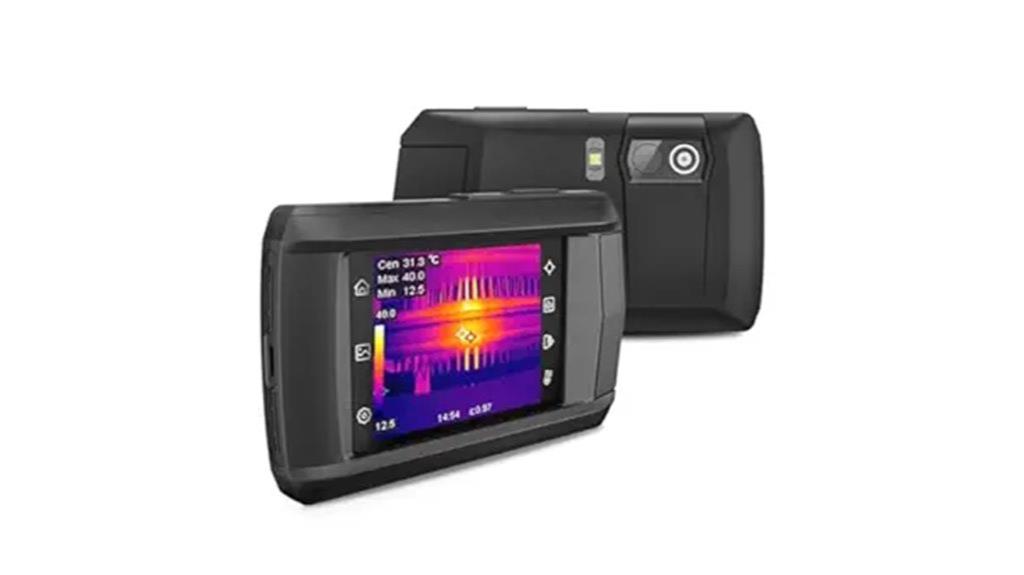
If you’re seeking a thermal leak detector that delivers crisp, high-definition images, the HP96 Thermal Imaging Camera with 240×240 resolution stands out. Its super resolution algorithm enhances image clarity during inspections, supported by a 96×96 IR sensor and a 640×480 visible camera. With five image modes—Thermal, Visual, Fusion, PIP, and Blending—you get detailed scene analysis. Its thermal sensitivity below 50mK and accuracy within ±2% detect tiny temperature differences, while the adjustable range from -4°F to 662°F ensures versatility. The user-friendly touchscreen, built-in storage, and durable IP54 design make it ideal for precise, reliable inspections in various environments.
Best For: professionals and technicians who need high-resolution thermal imaging for precise inspections in building diagnostics, electrical, and mechanical maintenance.
Pros:
- High 240×240 super resolution enhances image clarity during inspections.
- Supports multiple image modes (Thermal, Visual, Fusion, PIP, Blending) for versatile scene analysis.
- Durable IP54 rating with a rugged build and long battery life of up to 4 hours for reliable field use.
Cons:
- Slightly higher cost compared to lower-resolution thermal cameras.
- Requires familiarity with thermal imaging technology for optimal operation.
- Limited to a 3.5-inch touchscreen, which may be small for detailed adjustments during complex inspections.
Firecore Thermal Camera with 32GB Storage and PC Analysis

For professionals and serious DIYers seeking detailed thermal imaging without breaking the bank, the Firecore Thermal Camera with 32GB storage and PC analysis offers an excellent balance of features and affordability. Its 320 x 240 super resolution captures highly detailed images at 25Hz, ideal for quick surveys of electrical, mechanical, and building issues. With multiple color palettes and all-in-one thermal plus visible light modes, it enhances clarity and context. The device measures temperatures from -4°F to 1022°F with customizable alarms and adjustable emissivity, ensuring accuracy. Compact, durable, and easy to operate, it’s perfect for identifying hidden energy leaks and anomalies efficiently.
Best For: DIY enthusiasts, contractors, and technicians seeking reliable, detailed thermal imaging at an affordable price for building diagnostics, electrical inspections, and leak detection.
Pros:
- High-resolution 320 x 240 thermal images with 25Hz frame rate for clear, quick surveys
- Multiple color palettes and all-in-one thermal plus visible light modes for enhanced image clarity and context
- Durable, compact design with IP54 rating and drop protection, plus user-friendly features like quick boot and customizable alarms
Cons:
- LCD viewing angles are limited, especially from above, which can affect visibility
- Real-time projection features in the software are somewhat limited in functionality
- Slightly higher temperature readings compared to infrared thermometers may require calibration for precise measurements
F2W Thermal Camera with IR Resolution

The F2W Thermal Camera stands out with its HSFTOOLS Live Super Resolution algorithm, which enhances the image resolution from 256×192 to an impressive 640×480. This boost delivers sharper, more detailed images, making it easier to spot insulation gaps and hidden leaks. With <40 mK sensitivity and a 25Hz refresh rate, it provides HD smooth imaging suitable for fast inspections without lag. The camera automatically tracks temperature extremes and alerts you via visual, audio, or LED signals. Its precise measurements, adjustable emissivity, and intelligent scene detection make it a reliable tool for energy audits, leak detection, and maintenance tasks.
Best For: energy auditors, maintenance technicians, and DIY homeowners needing precise thermal imaging for detecting leaks, insulation issues, and electrical problems.
Pros:
- Enhanced image resolution with Super Resolution algorithm from 256×192 to 640×480 for clearer, more detailed images
- Rapid 25Hz refresh rate and HD imaging suitable for fast, lag-free inspections
- Intelligent scene detection and automatic temperature tracking for easier identification of anomalies
Cons:
- Slight artifacts in early units that may require customer service support for resolution
- Requires compatible smartphone or tablet for full functionality via Wi-Fi app
- Limited to ±3.6°F or ±2% measurement accuracy, which might not suit extremely precise applications
GOYOJO IR Thermal Imaging Camera for Android

Designed for Android users seeking a portable yet powerful thermal imaging solution, the GOYOJO IR Thermal Imaging Camera effortlessly turns your smartphone into a professional-grade thermal scanner. It connects via USB-C with the simple THG Start app, requiring no batteries or pairing. Its high-resolution sensor (192×192) captures detailed thermal images with a wide 50° field of view, perfect for large-area inspections like home energy audits or electrical troubleshooting. With a temperature range from -4°F to 752°F and ±2% accuracy, it offers reliable diagnostics. Its compact, durable design makes it ideal for on-the-go use, whether indoors, outdoors, or in tight spaces.
Best For: DIY enthusiasts, home inspectors, and professionals needing portable, detailed thermal imaging for troubleshooting and inspections.
Pros:
- High-resolution 192×192 infrared sensor captures detailed thermal images.
- Compact, pocket-sized design makes it highly portable and easy to carry.
- Compatible with most Android devices, enabling quick and easy setup via USB-C.
Cons:
- Not compatible with iPhone 15/16 series, limiting cross-platform use.
- Requires the THG Start app, which may demand initial setup time or updates.
- May have limited functionality or compatibility with some Android models.
Fieldpiece DR82 Infrared Refrigerant Leak Detector
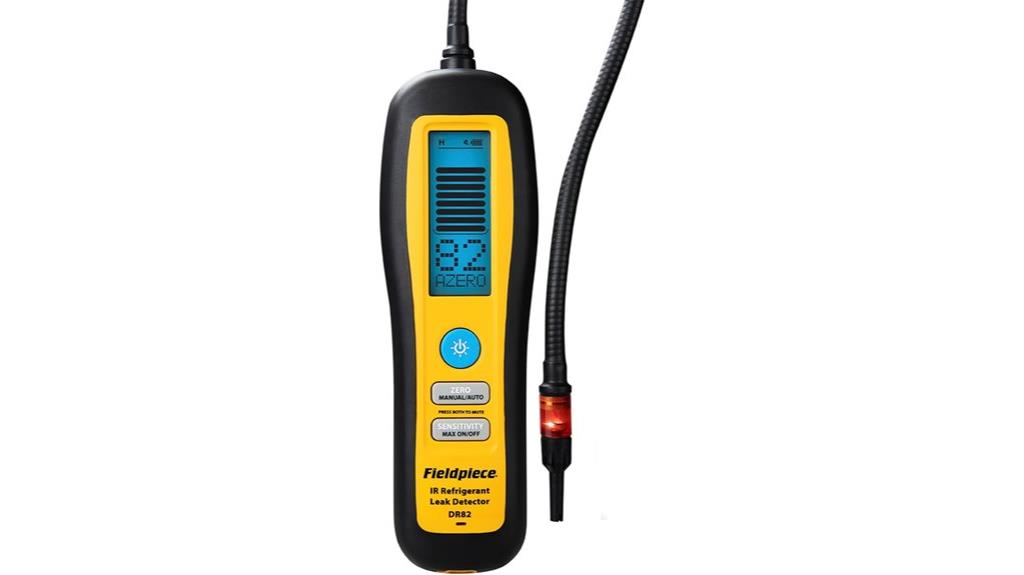
If you’re searching for a highly sensitive leak detector that can pinpoint even the smallest refrigerant leaks quickly, the Fieldpiece DR82 Infrared Refrigerant Leak Detector is an excellent choice. It detects micro leaks under 0.03 oz/yr and is 20 times more sensitive than bubble tests, thanks to infrared technology. It works with all refrigerant types, including CFC, HCFC, HFC, HFO, and blends. Its durable, moisture- and oil-resistant IP54 sensor has a 10-year lifespan, ensuring reliability. The 17-inch flexible probe, backlit LCD, and audible alerts make leak pinpointing straightforward, even in tight spaces. Long battery life and portability make it perfect for field use.
Best For: HVAC technicians and professionals seeking a highly sensitive, durable leak detector capable of pinpointing tiny refrigerant leaks quickly and efficiently.
Pros:
- Detects micro leaks less than 0.03 oz/yr, making it highly sensitive
- Compatible with all refrigerant types, including CFC, HCFC, HFC, HFO, and blends
- Features a durable, IP54-rated sensor with a 10-year lifespan for long-term reliability
Cons:
- May be more expensive than basic bubble test kits
- Requires regular filter tip replacements for optimal performance
- Its advanced features may have a learning curve for new users
CEM DT-8666 Digital Infrared Meat Thermometer Gun

With its rapid response time of just 0.15 seconds and a measurement range from -58°F to 716°F, the CEM DT-8666 Digital Infrared Meat Thermometer Gun stands out as an ideal choice for professionals and DIY enthusiasts who need quick, accurate temperature readings across various surfaces. Its laser targeting guarantees pinpoint accuracy, while the LCD display and color light alarm provide instant visual feedback. Built with durable ABS and drop protection, it’s suitable for indoor and outdoor use in cooking, HVAC, automotive, and leak detection tasks. Its user-friendly design and reliable performance make it a versatile tool for identifying hidden heat leaks and energy wastes effectively.
Best For: DIY enthusiasts, professional cooks, and technicians seeking quick, accurate non-contact temperature measurements for various indoor and outdoor applications.
Pros:
- Rapid response time of 0.15 seconds for instant readings
- Durable construction with drop protection and ABS material
- Versatile use across cooking, HVAC, automotive, and leak detection tasks
Cons:
- Some users may experience issues with laser beam functionality
- Warranty response can be inconsistent for certain customers
- Limited to indoor use despite outdoor capabilities, depending on environmental conditions
Elitech Refrigerant Leak Detector with Infrared & Heated Diode Sensors
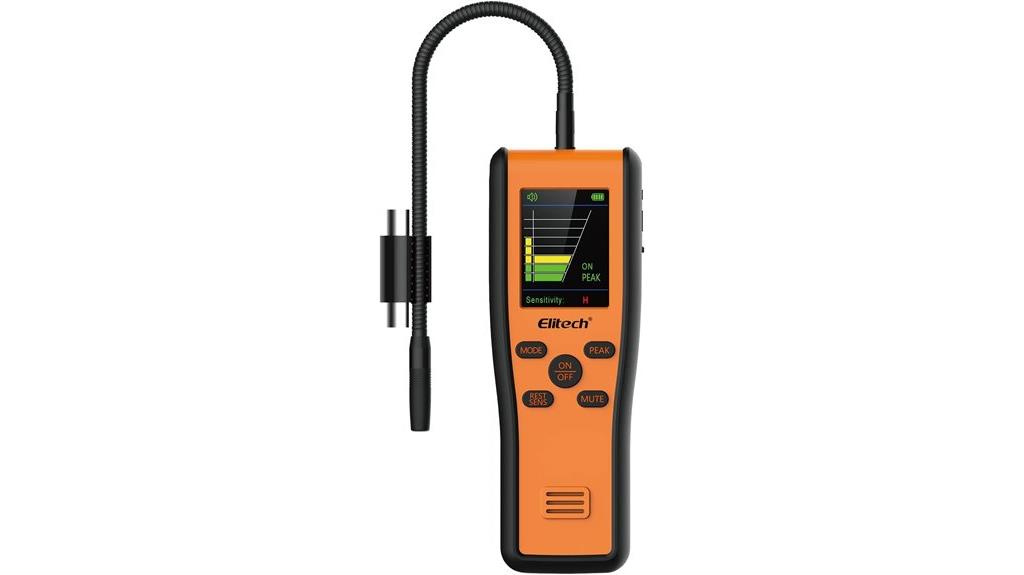
The Elitech IR-200 stands out as an excellent choice for HVAC professionals who need a portable, highly accurate refrigerant leak detector. It combines infrared and heated diode sensors, allowing quick switching between modes for thorough detection. With a detection range covering all halogenated refrigerants, it’s versatile and reliable. Its large screen displays leak peaks clearly, aiding precise localization. Weighing just 2 pounds and operating wirelessly, it’s perfect for tight or hard-to-reach spaces. Though some sensors may wear over time, users generally praise its accuracy and durability. Overall, the IR-200 offers a solid balance of performance, usability, and value for professionals.
Best For: HVAC professionals seeking a portable, accurate refrigerant leak detector capable of detecting all halogenated refrigerants with quick sensor switching and clear leak localization.
Pros:
- Combines infrared and heated diode sensors for comprehensive detection and quick mode switching.
- Lightweight and wireless design ideal for tight or hard-to-reach spaces.
- Large screen displays leak peaks clearly, enhancing leak localization accuracy.
Cons:
- Plastic sensor tips may break when used in rough or tight spaces.
- Heated diode sensor can fail after approximately 1.5 years of extended use.
- Limited support responses regarding sensor longevity issues.
FLIR TG165-X Thermal Imaging Camera
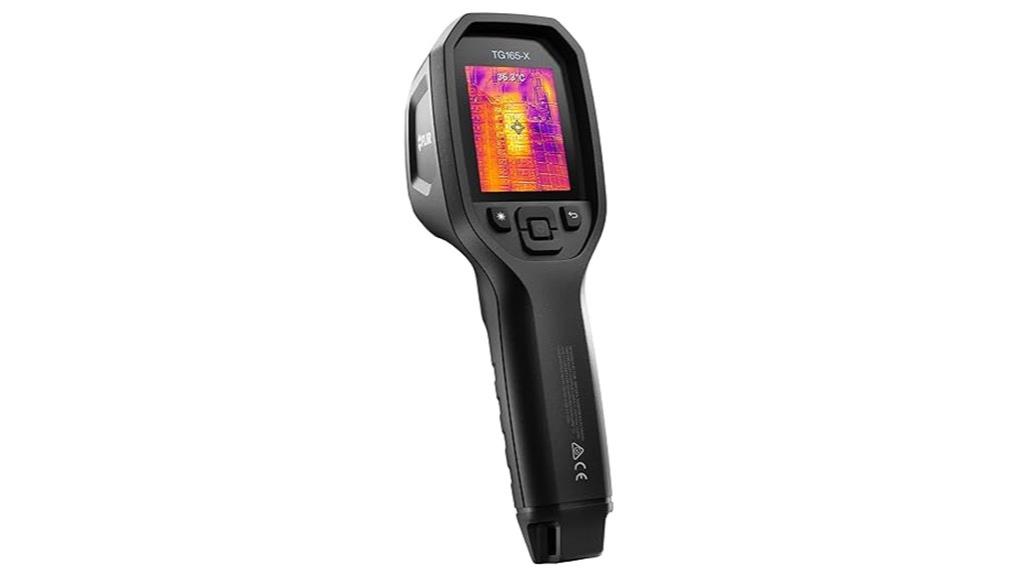
The FLIR TG165-X Thermal Imaging Camera stands out as an excellent choice for DIY enthusiasts and professionals needing quick, reliable thermal inspections. It features a 4,800-pixel IR sensor that measures temperatures from -25°C to 300°C, with MSX image enhancement for sharper visuals. The device includes a laser pointer for precise targeting, a built-in flashlight, and a user-friendly interface. Its rugged, drop-tested design with IP54 protection guarantees durability. With internal storage for 50,000 images, Bluetooth transfer, and a 9Hz frame rate, it’s ideal for detecting electrical faults, leaks, and insulation issues. It’s compact, ergonomic, and ready for versatile inspection tasks.
Best For: DIY enthusiasts and professionals seeking a reliable, easy-to-use thermal camera for quick inspections of electrical, mechanical, and building issues.
Pros:
- Sharp images with MSX image enhancement for clear detail
- Rugged, drop-tested design with IP54 protection for durability
- Large internal storage capacity and Bluetooth transfer for easy data management
Cons:
- Lacks maximum and minimum temperature readings found in lower-cost models
- Battery life can drain quickly with extended use
- Some users report hardware issues or device freezing after prolonged use
Factors to Consider When Choosing a Thermal Leak Detector Infrared

When selecting a thermal leak detector infrared, I focus on several key factors to guarantee it meets my needs. Features like detection range, sensor accuracy, and ease of use play a big role in my decision-making process. Understanding these points helps me choose a device that’s reliable, user-friendly, and durable.
Detection Range Capabilities
Understanding the detection range of a thermal leak detector is essential because it determines how far you can stand from the surface to accurately identify temperature differences or leaks. A wider detection range allows you to cover larger areas or hard-to-reach spots without needing close contact. This is often expressed as a “distance-to-spot ratio,” like 12:1 or 16:1, showing how far the device can be from the surface relative to the measured area. Higher ratios mean you can inspect from a safer distance, making the process more efficient and less intrusive. Keep in mind, factors like surface emissivity, ambient conditions, and the technology used can influence the actual detection distance. Choosing a device with an appropriate range boosts inspection safety and effectiveness.
Sensor Accuracy and Sensitivity
Choosing a thermal leak detector with high sensor accuracy and sensitivity is key to pinpointing even the smallest temperature differences. Sensors with sensitivity below 50mK enable me to detect subtle leaks that might otherwise go unnoticed. Accurate sensors should measure temperatures within ±2%, ensuring reliable results across various conditions. A wide temperature detection range, like -58°F to 1022°F, allows me to identify leaks in different environments, from cold to hot. Response time matters too—ideally under 500ms—so I can quickly confirm leak spots. Consistent accuracy over time, regardless of humidity or temperature changes, guarantees dependable detection. These factors ensure I don’t miss hidden energy losses, making my inspections more precise and efficient.
Emissivity Adjustment Features
Adjusting emissivity settings on a thermal leak detector is essential because different surfaces emit infrared radiation differently, affecting measurement accuracy. Surfaces like painted walls or human skin have high emissivity values, often around 0.95, which means they emit more infrared radiation. Organic or oxidized surfaces require accurate calibration to these values for precise readings. Conversely, shiny or reflective surfaces like metals have low emissivity, sometimes below 0.2, which can cause significant measurement errors if not properly adjusted. An adjustable emissivity feature allows me to calibrate the device for a variety of materials, ensuring reliable results across different surfaces. Without proper adjustment, readings can be off by several degrees, leading to inaccurate assessments of energy leaks or temperature variations.
Ease of Use Design
When selecting a thermal leak detector infrared, prioritizing ease of use can make a significant difference in your inspections. An intuitive interface with clear buttons and simple controls allows you to operate the device quickly, even if you’re new to thermal imaging. Ergonomic design, including comfortable grips and lightweight construction, helps prevent fatigue during prolonged use. Visual indicators like LED lights, digital displays, or color-coded alerts enable rapid interpretation of results, saving you time. Features such as automatic data hold, auto-off, and adjustable sensitivity simplify workflow and boost accuracy. Additionally, a compact, portable form factor with accessories like lanyards or carrying cases makes handling and maneuvering easier across different environments, ensuring efficient and stress-free inspections.
Durability and Build Quality
A thermal leak detector’s durability directly impacts its reliability and lifespan, especially when used in demanding environments. An IP54 or higher rating is essential to protect against dust and water, ensuring consistent performance despite harsh conditions. The outer casing should be made from impact-resistant materials like ABS plastic or reinforced rubber to withstand drops and shocks. Reinforced seals around sensors and buttons prevent damage from debris or moisture, extending the device’s life. High-quality sensors, such as infrared or heated diodes, also contribute to longevity, maintaining accuracy over time. Additionally, ergonomic features like non-slip grips and balanced weight distribution help the detector endure frequent use without wearing down or degrading. Overall, a well-built detector promises durability, reliable measurements, and long-term value.
Compatibility With Materials
Choosing a thermal leak detector that works well with different materials requires careful consideration of its compatibility features. I look for devices with adjustable emissivity settings, so I can match surfaces like metal, plastic, or wood for accurate readings. It’s also important that the detector can identify temperature differences on reflective or non-porous surfaces, which often challenge infrared measurements. Some models come with specialized sensors or modes tailored for specific materials such as refrigerants or insulation, enhancing accuracy. Additionally, I check if the device’s temperature range and sensitivity suit materials with varying thermal conductivities, like concrete or thin plastics. Finally, reliable performance across diverse surface textures and colors, including painted or oxidized finishes, guarantees I get consistent, trustworthy results in different environments.
Power Source Convenience
The power source of a thermal leak detector plays a crucial role in ensuring it’s practical and reliable during inspections. Most models run on batteries, such as AA, AAA, or 9V, which directly influence portability and ease of use. Rechargeable lithium-ion batteries are a popular choice because they offer convenience for frequent testing, reducing waste and ongoing costs. Some detectors feature USB-C or dedicated charging ports, allowing quick recharging without removing batteries—ideal for on-the-spot diagnostics. Battery life varies across models; professional-grade devices typically provide longer run times, suitable for extensive inspections. Ultimately, selecting a detector with a convenient power source means you can operate it in remote locations or tight spaces without power outlets, ensuring consistent performance when you need it most.
Software and Data Storage
When choosing a thermal leak detector, it’s essential to take into account its software capabilities and data storage options. I look for devices with ample internal storage, like 32GB or more, so I can save numerous images and videos without constantly transferring files. Easy data transfer methods such as USB, Wi-Fi, or Bluetooth are crucial for seamless analysis and reporting. The accompanying software should offer features like image annotation, comparison, real-time monitoring, and firmware updates to improve accuracy and usability. Compatibility with my operating system—Windows, macOS, or Android—is vital, and I prefer devices that don’t require complicated downloads or pose security risks. Lastly, I check if the device supports firmware upgrades to guarantee it stays current and reliable over time.
Frequently Asked Questions
How Accurate Are Infrared Leak Detectors in Different Environmental Conditions?
Infrared leak detectors are generally very accurate, but their precision can vary based on environmental conditions. I’ve found that high humidity, rain, or extreme temperatures can sometimes interfere with readings, making it harder to spot subtle leaks. Still, when used correctly in stable conditions, they provide reliable, clear images of energy losses. For best results, I recommend testing in moderate weather and ensuring the detector is well-calibrated.
Can Thermal Leak Detectors Identify Hidden Leaks Behind Walls?
Did you know that up to 30% of energy loss in buildings can come from hidden leaks? Yes, thermal leak detectors can often spot leaks behind walls, but their effectiveness depends on wall material and temperature differences. I’ve found that high-quality detectors with good sensitivity can detect temperature variations through drywall and other materials. Just keep in mind, sometimes a combination of tools and methods yields the best results for hidden leaks.
What Is the Typical Detection Range for Various Infrared Thermal Cameras?
The detection range of infrared thermal cameras varies depending on the model and specifications. Typically, handheld cameras can detect temperature differences from a few inches up to 300 feet or more. Professional-grade units often have a range of 100 to 300 meters, allowing for broader inspections. Keep in mind that factors like camera sensitivity, lens size, and environmental conditions also influence how far you can effectively detect thermal anomalies.
Are There Specific Models Suitable for Residential Versus Commercial Use?
Did you know that some thermal leak detectors can spot energy losses as small as 0.02°C? For residential use, I recommend compact, user-friendly models like the Fluke TiS series, perfect for quick inspections. Commercial settings, however, benefit from advanced, higher-range detectors like the FLIR T-Series, which can cover larger areas efficiently. I find choosing the right model makes energy audits more precise and hassle-free.
How Do Different IR Resolutions Impact Leak Detection Effectiveness?
Higher IR resolutions allow me to detect smaller temperature differences, making it easier to spot hidden leaks and energy wastes. With better resolution, I can pinpoint issues more precisely, reducing false alarms and ensuring I don’t miss subtle leaks. Lower resolutions might miss minor problems, but they’re often enough for larger issues. So, I always choose a detector with high IR resolution for detailed, accurate leak detection.
Conclusion
Did you know that using a thermal leak detector can save you up to 30% on energy bills? Finding hidden leaks isn’t just about comfort—it’s about efficiency and savings. With options like the BLACK+DECKER or FLIR models, you can quickly identify energy wastes before they become costly. Investing in the right infrared leak detector not only protects your home but also helps reduce your carbon footprint. Don’t wait—start spotting those leaks today!









